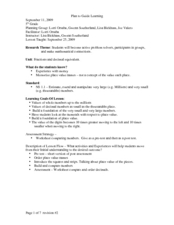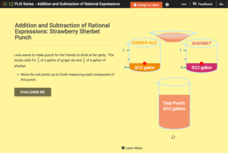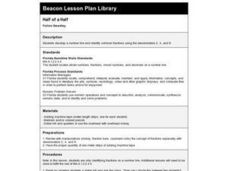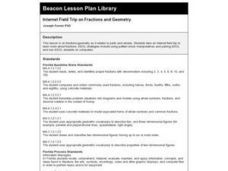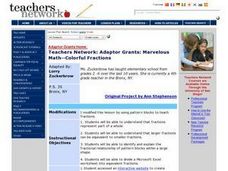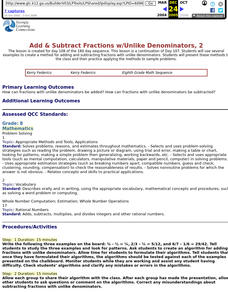Curated OER
Fractions and Decimal Equivalents: Fifth Grade
Sometimes a skeleton is all you get. This lesson outline provides teachers with a basic lesson flow. Pupils will pre-test, order place value names, use manipulatives, and build and compare numbers. How this is to be done is not...
Curated OER
Math Manipulative: "Fraction Sticks"
Fifth graders use sets of fraction sticks to color in fractional amounts and determine how to compare pairs of fractions. In this math lesson, 5th graders insert the correct symbol given the fractions they are working with. Instructions...
Curated OER
Comparing Fractions Showdown
Learners work in groups to compare fractions. They check their answers using fraction manipulatives. They write their answers on a white board.
David Pleacher
Candy Math Fun
Few things can motivate children to learn like the promise of a sweet and tasty treat. Given a bag of M&M®s, Skittles®, or other colorful candy, students first predict the contents of the bag before counting the pieces,...
CK-12 Foundation
Addition and Subtraction of Rational Expressions: Strawberry Sherbet Punch
Explore the connection between fractions and rational expressions. Young scholars manipulate fractions with unlike denominators to find a total. Challenge questions allow them to check their work to ensure they are correct.
CK-12 Foundation
Midpoint and Segment Bisectors: Midpoint Map
Discover how to find a midpoint with a conceptual exploration. Scholars manipulate a point to determine the location of a midpoint on a straight line distance between two locations. Later questions extend to determine the...
Curated OER
Comparing and Ordering Decimals - Complete Lesson Plan
Base ten blocks serve as visual representations of numbers that include decimals to the hundredths place. Children compare and order decimals in their math journal as they build the corresponding numbers with base ten blocks.
Curated OER
All Kinds of Numbers
Count and compare numbers and fractions using "greater than" and "less than." Learners count on by 2s and 10s and represent the end number with base ten blocks, counters, and cups. They use circle stickers to illustrate fractions and...
Curated OER
Half of a Half
After your math classes have been introduced to fractions (especially those with denominators of two, four, and eight), introduce them to fractions on a number line with this lesson. Using a meter length of tape, show your class where...
EngageNY
Creating Division Stories
Create your own adventure story ... well, not really. The fifth lesson in a 21-part series has pairs create story contexts for division problems. The lesson presents a step-by-step process for pupils to follow in writing such stories.
EngageNY
Collecting Rational Number Like Terms
Teach pupils to handle fractions fluently. The sixth installment in the series of 28 has class members apply the concepts learned in previous lessons to expressions with fractional coefficients. The fractions are both mixed numbers and...
Curated OER
Comparing Fractions
Students use the assistance of computers to explore reducing fractions. Using various internet activities, students experience comparing and ordering fractions. They develop methods to estimate the value of fractions.
Curated OER
Introduction to Fractions on the Numberline
Students use color-cued fraction strips and a color-cued numberline to develop basic fraction concepts and correct sequencing. They complete a worksheet using equivalent fractions to solve the problems.
Curated OER
Models for Dividing Fractions
Sixth graders represent division of fractions using manipulatives, such as freezer pops, candy bars, and models such as drawings squares. They develop an algorithm from these examples and solve problems using fractions.
Curated OER
What's a Per-"cent"?
Students recognize the mathematical connections between fractions and percents. They develop and study graphs to make connections between their data and what it represents. They write about the connections they have discovered.
Curated OER
Fractions and Decimals
Third graders use fractions manipulatives to explore fractions. In this fraction lesson, 3rd graders work in groups based on skill to increase understanding of fractions. Students create fraction books.
Curated OER
Fractions: Mud Pie Math
Second graders identify and name fractional parts through the use of mud pie manipulatives. In this fractional manipulatives lesson, 2nd graders identify and label halves, thirds, fourths, sixths, eighths, and tenths and order them...
T. Smith Publishing
Fraction Manipulatives
Photocopy these coloful disks onto cardstock, laminate, and then cut out to use as manipulatives when teaching your class about wholes, halves, thirds, and fourths. It is always so helpful to practice math concepts with hands-on...
Curated OER
Internet Field Trip on Fractions and Geometry
Students take an Internet field trip to research fractions. ESOL strategies include using pattern block manipulatives and pairing ESOL and non-ESOL students on computers.
Curated OER
Fractions in Shapes
First graders explore fractions with manipulatives. In this fraction activity, 1st graders use paper foods such as sandwiches and pizza in order to find halves, thirds, fourths, eighths, and more. This activity is divided up into 3 tiers...
Curated OER
Comparing and Ordering Fractions
Third graders create fractions from concrete materials, then use paper fractions.
Curated OER
Pizza Fractions
Students investigate relationships among fractions and use cut out pizzas and fraction circles to compare equivalent fractions. They exchange fractional parts of construction paper pizza circles to use as many different fractional parts...
Curated OER
Marvelous Math -- Colorful Fractions
Pupils begin the lesson by discovering that a fraction is one part of a whole. In groups, they practice reducting larger fractions into small fractions and discovering they are equal. They use blocks to identify the relationship...
Curated OER
Add & Subtract Fractions w/Unlike Denominators, 2
Young scholars use several examples to create a method for adding and subtracting fractions with unlike denominators. They present these methods to the class and then practice applying methods to sample problems.
